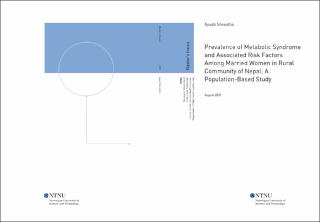| dc.description.abstract | ABSTRACT
Introduction: Metabolic syndrome (MetS) is a constellation of conditions including hypertension, hyperglycemia, central obesity and dyslipidemia, known to increase the risk for diabetes type 2 (T2D) and cardiovascular diseases (CVDs), the leading cause of death worldwide. MetS has become a global epidemic, affecting ≈ 25% of the world's population. The burden of MetS is increasing, especially among South Asians. Several studies have reported a higher prevalence of MetS among women. Given that very few studies have addressed MetS in rural women in Nepal, we sought to estimate the prevalence of MetS and its risk factors among women in a rural district.
Methods: This cross-sectional sub-study is part of a larger study conducted in Bolde village of Nepal, including 743 women. The participants were recruited from a study conducted in 2013, where married, non-pregnant women age 15-81 years were included. The same inclusion criteria were applied in the present study. The Joint Interim Statement (JIS) definition of MetS was used for assessment of prevalence, which defines MetS as presence of any three of the following: waist circumference (WC) ≥ 80 cm, triglycerides (TG) ≥ 1.7 mmol/L, high-density lipoprotein cholesterol (HDL-C) < 1.29 mmol/L, or on treatment for these dyslipidemias, systolic blood pressure (SBP) ≥130 mm Hg and/or diastolic blood pressure (DBP) ≥ 85 mm Hg, or on treatment for hypertension; and fasting plasma glucose (FPG) ≥ 5.6 mmol/L, previously diagnosed T2D, or on treatment for T2D. HbA1c was used as criterion for hyperglycemia instead of FPG. For comparison with previous studies, prevalence was also estimated according to the Adult Treatment Panel III (ATP III) and International Diabetes Federation (IDF) definitions of MetS. Fasting blood samples were collected, and height, weight, WC, and BP were measured. Asian cut-offs were used for BMI and WC. A questionnaire addressing among others socio-demographic, dietary factors, smoking, alcohol consumption and physical activity was filled in. Hemoglobin A1c (HbA1c) measurements were performed consecutively. Sera were stored at -80C until analyses of lipid profile. All analyses were performed at Dhulikhel hospital.
Results: Altogether, 716 women aged 48.3 ± 11.7 years were included, based on the access to all parameters of the MetS. The prevalence of MetS was according to JIS was 37.7%, and 27.4 and 30.3% according to ATP III and IDF definitions, respectively. Low HDL-C was the most prevalent component (57.0%), followed by high WC (45.3%). The prevalence of MetS increased steadily with age, the age group ≥ 61 years being about five times more likely to have MetS than those of 21-30 years (crude OR= 4.8, 95% CI = 1.87, 12.37). MetS was also frequent in younger age groups. In addition to age, high BMI, postmenopausal status, and Dalit ethnicity were risk factors for MetS.
Conclusion: The prevalence of MetS among women of rural Nepal was high even at young ages and increased steadily with age. Low HDL-C and abdominal obesity were the most frequent components. Given the increased risk of CVDs and T2D in subjects with MetS, our findings are of concern, and efforts to prevent these abnormalities through awareness campaigns and lifestyle modification should be commenced, encouraged and sustained in order to reduce complications. | |
